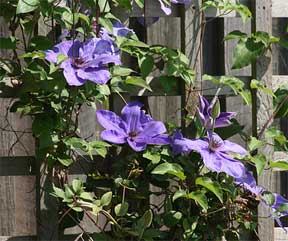Of all ornamental plants, climbers are considered most valuable. They curtain outside walls and spiral up pillars with a luxurious cover of foliage and often magnificent flowers. They frame garden fences, arbors and entrances and soften their architectural formality.
The clematis is one of the easiest grown of the ornamental vines. When well established it will blanket itself with a volume of buds which will open in mid-May with flowers measuring 4 to 6 inches across and continue to bloom until mid-September. Although clematis blooms appear to have a fine china delicacy, they are able to withstand severe weather conditions, especially heavy rains. An individual flower can be expected to last from 6 to 10 days on the vine.

Culture for Clematis
Clematis culture begins at planting time. Clematis may be planted either in fall or spring; both times have their advantages. Fall planting should be done early, so that plants may become established before severe winter freezing. Plants set out in the spring have no threat from winterkill and at this time of the year the soil is damp and ready to start the dormant plants as soon as the weather warms sufficiently.
Follow planting instructions. Clematis requires good drainage, rich soil and lime. Dig a hole 18 inches deep and 18 inches across. If you have clay soil you may want to go a little deeper. Fill this hole with rocks or stones, leaving 12 inches of the hole unfilled. If you have any sand available put it on the stones to help fill up the spaces between the stones. This will help the drainage problem. Clematis like a rich soil so mix a cup of fertilizer and two cups of lime in a 10 quart pail of good garden loam or potting soil and fill in the rest of the hole. When planting be sure to point the roots straight down and firm the soil around them.
Stake Immediately
Stake the vines at once as they will not grow without something to climb on. At the height of the growing season they will grow as much as a foot a day. Don’t look for this growth in a newly planted clematis, however.
For support you may use a trellis, cedar post, a porch pillar or a garden fence. It is important that the vines be planted where they will receive at least 5 hours of sun a day and protection from high winds. Also remember that although they thrive in heat and bright sun, the vines do their best when shaded at the base. They have been called hot headed plants with cold feet.
Pruning should take place in January or February as the growth buds swell. In order not to cut away too much of the flowering wood, prune just above the joint from which new growth is desired. If allowed to ramble at will, clematis becomes completely tangled, and thinning becomes impossible. At least half of the growth should be pruned back each year to provide a succession of new flowering wood.
To Get New Plants
The home gardener can increase his plants by propagating by means of layering. At pruning time selected shoots are shortened to a length of 5 or 6 feet. A two inch slice is made on the under side of the shoot. This sliced area is put into a six inch pot of sandy soil. The layer is then well covered with soil and the pot is sunk into the ground. By October or November the plant may be severed from the parent and moved to a permanent location.
Trim to two feet and stake before moving. If you buy from a nursery, your clematis will come to you most likely in a pot. When planting, the crown (the part of the vine from which the roots spread) should be two inches below soil level. This gives the plants a chance to produce new roots above the crown after planting. Nurserymen distinguish two distinct groups of clematis – the species, which have small flowers, and the hybrids, which are large flowered. In both groups there is a great selection and all offer beautiful and graceful forms and color.
